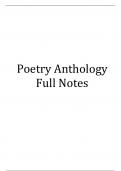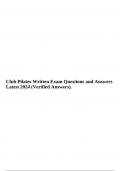Poetry Anthology
Full Notes
, 2
Contents
Table of Contents
English Literature Paper 2 – Section B: Poetry Anthology ......................................................................... 3
Poems ............................................................................................................................................... 4-33
Ozymandias ...................................................................................................................................................................................................... 4-5
London ............................................................................................................................................................................................................... 6-7
The Prelude ...................................................................................................................................................................................................... 8-9
My Last Duchess ........................................................................................................................................................................................10-11
Storm on the Island...................................................................................................................................................................................12-13
Tissue .............................................................................................................................................................................................................14-15
The Emigrée .................................................................................................................................................................................................16-17
Checking Out Me History .......................................................................................................................................................................18-19
The Charge of the Light Brigade ..........................................................................................................................................................20-21
Exposure .......................................................................................................................................................................................................22-23
Bayonet Charge...........................................................................................................................................................................................24-25
Remains .........................................................................................................................................................................................................26-27
Poppies ...........................................................................................................................................................................................................28-29
War Photographer.....................................................................................................................................................................................30-31
Kamikaze ......................................................................................................................................................................................................32-33
Messages.............................................................................................................................................. 34
Themes ................................................................................................................................................ 35
Authors and Publication Dates .............................................................................................................. 35
, 3
Literature Paper 2 - Section B: Poetry Anthology
Literature Paper 2
2 Hour 15 Minutes for the Entire Paper
• Section A: Modern Text – Lord of the Flies (30 marks)
• Section B: Poetry Anthology (30 marks)
• Section C: Unseen Poetry (32 marks)
Section B: Poetry Anthology
The question asks you to: compare the ways poets present [theme] in [poem] and in on other poem
• E.g. compare the ways poets present ideas about power in ‘Ozymandias’ and in one other poem from
‘Power and conflict’.
A01: Message – 12 Marks A02: Analysis – 12 Marks A03: Context – 6 Marks
What Kind of Connections can you find between Poems?
1. Method: Imagery, form, structure, etc.
2. Content: Similar events/characters with slight differences.
3. Attitudes: Different attitudes of main speakers in poem or different attitudes of writers.
The connections you make should enable you to say something about the ways in which the poems
are different. Similarities can still be mentioned.
The best choice for the second poem is the one that treats a similar idea to the one in the title but has a
different perspective on and presentation of it.
Try to give multiple interpretations of each example you give.
Structure of the Response
1. Introduction: Focus on similarities and differences, mention the writer’s name and talk about the given
poem first. No A02 or A03 in the intro.
2. Three Comparative Sections: Identify a point of comparison between the two poems, relevant to the
title. Outline it in a clear first sentence. Explore this point of comparison in the first poem first, then
explore it in the second poem, but compare throughout. Context should be included in at least 2, but
ideally all 3 sections and it must be relevant.
3. Conclusion: Refocus on the overall differences between the poems, evaluating the different effects of
them in terms of the question.
, 4
Ozymandias (1818)
Percy Bysshe Shelley (1792-1822)
Story
• The narrator meets a traveller who tells him about a statue standing in the middle of the desert.
• It’s a statue of a king who ruled over a past civilisation.
• His face is proud and he arrogantly boasts about how powerful he is in an inscription on the statue’s base.
• However the statue has fallen down and crumbled away so that only the ruins remain.
Structure
• The narrator builds up an image of the statue in the octet by focusing on different parts of it in turn.
• The poem ends by describing the enormous desert in the sestet, which helps to sum up the insignificance of the
statue.
Language
• Irony: There’s nothing left to show for the ruler’s arrogant boasting or his great civilisation. The ruined statue can
be seen as a symbol for the temporary nature of political power or human achievement. Shelley’s use of irony
reflects his hatred of oppression and his belief that it is possible to overturn social and political order.
• Power: The poem focuses on the power of Ozymandias, representing human power. However, this power has
been lost and is only visible due to the power of art. Ultimately, nature has ruined the statue, showing that nature
and time have more power than anything else.
• Anger: The tyranny of the ruler is suggested through aggressive language.
• Pride: The ruler was proud of that he’d achieved. He called on other rulers to admire what he did.
• Arrogance: The inscription shows that the ruler believed that he was the most powerful ruler in the land – nobody
else could compete with him. He also thought he was better than those he ruled.
• Art: Human civilisations and achievements are insignificant compared to the passing of time. Art has the power
to preserve elements of human existence, but it is also temporary.
Form
• The poem is a sonnet, with a volta at line 9, like a Petrarchan sonnet.
• However, it doesn’t follow a regular sonnet rhyme scheme, perhaps reflecting the way that human power and
structures can be destroyed.
• It uses iambic pentameter, but this is also often disrupted.
• The story is a second-hand account (an elusive framing device to frame the main event), which distances the
reader even further from the dead king.
, 5
Ozymandias (1818)
Context
Shelley:
• Shelley was well known as a ‘radical’ (like Blake) during his lifetime and some people think ‘Ozymandias’
reflects this side of his character.
• Shelley was also a Romantic poet, who believed in the power of art.
• Shelley was critical of the royal family and monarchical government in England and sympathised with the ideals
behind the French Revolution (like Blake).
• ‘Ozymandias’ has been read by some as a condemnation of undemocratic or tyrannical government, reflecting
Shelley’s radical views.
The Poem:
• Although it is about the remains of a statue of Ozymandias (another name for the Egyptian pharaoh Rameses II) it
can be read as a criticism of people or systems that become huge and believe themselves to be invincible.
• The poem was written in late 1817 as part of a competition between Shelley and his friend Horace Smith, and was
published in The Examiner in January 1818
• The poem is thought to have been inspired by a gigantic statue of Rameses II that was brought for the British
Museum by the Italian explorer Giovanni Belzoni.
Quotations
• “I met a traveller from an antique land” – L1: Begins with I, but continues with a mysterious speaker
(ambiguous); poem is framed as a story – the narrator has not actually seen the statue, emphasising how
unimportant Ozymandias has become.
• “Two vast and trunkless legs of stone” – L2: Statue is described as large, but also incomplete; it is without legs,
making Ozymandias seem powerless.
• “whose frown, / And wrinkled lip, and sneer of cold command,” – L4-5: The sculptor understood the
arrogance of Ozymandias, reinforced by triplet; ‘frown’ and ‘sneer’ highlight his cruelty; ‘cold command’ suggest
he did not use his power justly.
• “The hand that mocked them, and the heart that fed” – L8: i.e. the heart of Ozymandias was fed by those he
ruled over, depicting him as a power-hungry tyrant; ‘mocked’ suggests the sculptor intended to ridicule him.
• “My name is Ozymandias, King of Kings; / Look on my Works, ye Mighty, and despair!” – L10-11:
Demonstrates the power Ozymandias had during his reign; he claims to be more powerful than any king, almost
like a God; lineation of ‘Look’ heightens Ozymandias’s tone of command; ironic – he tells other rulers to despair
because of the size and grandeur of his works, but in reality they should despair because their power is temporary
and ultimately unimportant, like his.
• “Nothing beside remains.” – L12: Ironic (after previous two lines) – caesura after ‘remains’ emphasises that
ultimately Ozymandias’s power is inconsequential compared to the passing of time.
• “Round the decay / Of that colossal Wreck” – L12-13: Juxtaposition of ‘colossal’ and ‘wreck’ reinforce the
idea that despite Ozymandias’s beliefs, his power is futile; ‘decay’ reflects how his power deteriorated over time.
• “boundless and bare / The lone and level sands stretch far away.” – L13-14: Alliteration emphasises the
feeling of emptiness surrounding the statue; the desert is vast and survives longer than the broken statue,
emphasising the insignificance of the statue and Ozymandias.






